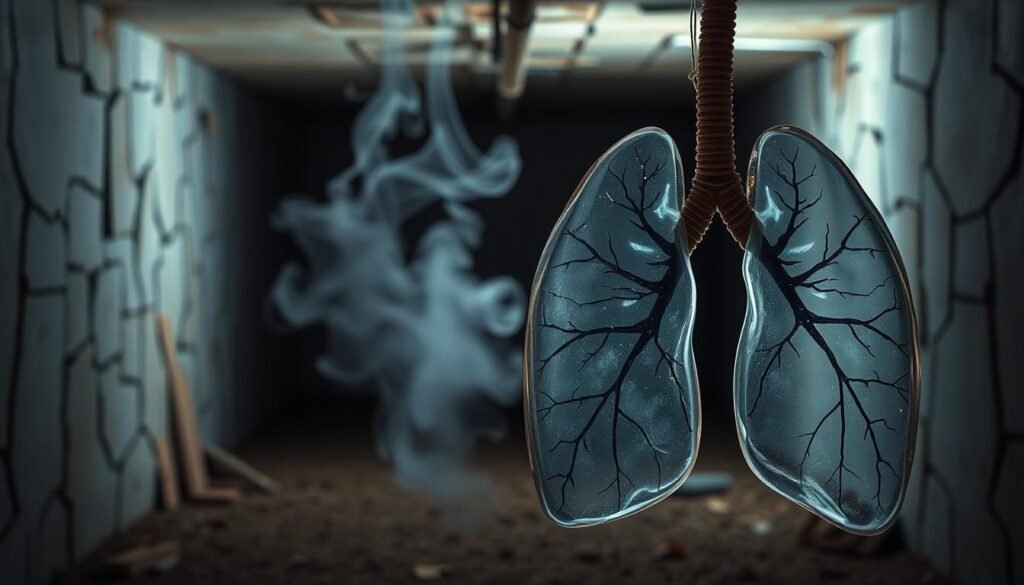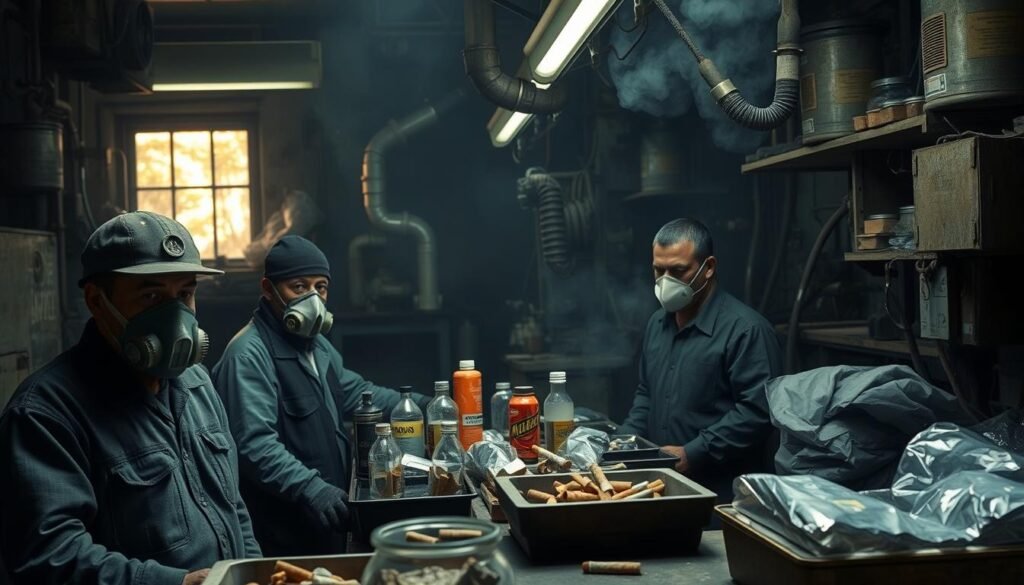Tobacco use leads to 70% of lung cancer cases. It’s the top cause of cancer deaths in the U.S. Over 238,000 Americans might get diagnosed with lung cancer this year. It’s crucial to Avoid Tobacco to lower lung cancer risk. Not using tobacco improves lung health and can lead to a longer, healthier life.
This article shares important facts and tips on avoiding tobacco. This can help lower lung cancer risks. Knowing about the dangers of smoking, secondhand smoke, and carcinogens is key. With this knowledge, people can choose a healthier lifestyle. This puts cancer prevention first.
Key Takeaways
- Tobacco smoke is linked to over 70% of lung cancer cases.
- Quitting smoking can halve your risk of lung cancer after 10 years.
- Secondhand smoke also increases the likelihood of developing lung cancer.
- Regular health check-ups can help in early detection and prevention.
- Engaging in healthy lifestyle choices reinforces overall cancer prevention.
Understanding Lung Cancer Risk Factors
It’s very important to know what causes lung cancer to prevent it. Smoking is the main reason behind lung cancer. About 90% of cases come from it. Smokers breathe in lots of bad chemicals. This greatly raises their risk of getting sick.
There are other dangers in the environment that cause lung cancer too. Radon gas causes about 30% of lung cancer deaths in non-smokers. This gas can leak into houses and become a big problem. Also, being around asbestos at work causes many cases of a certain cancer called mesothelioma.
Having family members with lung cancer also increases your risk. If your relatives have had it, your own risk might be double. It’s key to keep an eye on your health and think about ways to not get sick.
You can’t stop all lung cancers. But, you can do a lot to lower your risk. Avoiding smoking and staying away from harmful places is a good start. Choosing healthy habits is a big part of preventing cancer.
The Link Between Tobacco and Lung Cancer
Tobacco use and lung cancer have a significant and alarming connection. Roughly one-third of all cancers stem from tobacco use. Studies show that 80% to 90% of lung cancer cases are due to smoking.
This fact highlights the need for action against smoking-related diseases.
Tobacco’s harm goes beyond lung cancer. It increases the risk of cancers in the bladder, mouth, and throat. Smoking-related health costs were huge in Europe, reaching up to €130 billion in 2000.
Though only 15% of people live in Europe, it sees a big part of tobacco-related disease burdens globally.
Young folks and poorer communities are especially at risk from tobacco. Raising tobacco prices by 10% could lower smoking by up to 4%. Many countries have introduced laws to make public spaces smoke-free.
These laws help smokers quit and stop young people from starting. They also spread awareness about the dangers of smoking.
E-cigarettes, seen as less harmful, still have dangerous chemicals. They’re risky for users and those around them. Smoking men are 23 times likelier to get lung cancer compared to nonsmokers.
And lung cancer in young patients under 40 is concerning, occurring in one percent of cases.
| Statistic | Value |
|---|---|
| Tobacco use attributed to cancers | Approximately 1/3 of all cancers |
| Tobacco’s contribution to lung cancer cases | 80-90% |
| Annual premature deaths in Europe due to smoking | More than 650,000 |
| Economic cost in Europe (2000) | €98-130 billion |
| Prevalence of tobacco use in EU adults | 29% |
Fighting tobacco use is key to cutting lung cancer rates and boosting public health. Ongoing research into tobacco’s effects shows we need a better grasp of nicotine addiction. This understanding is crucial for creating a healthier society.
When You Avoid Tobacco, You Reduce Your Risk of Lung Cancer
Avoiding tobacco lowers your chance of getting lung cancer. Studies show people who don’t start smoking or quit later can greatly reduce their lung cancer risk. Not smoking also boosts overall health.
Once you stop smoking, your lungs start to heal. They can get better over time, leading to stronger lungs. People who quit smoking lower their lung cancer risk by up to 50% after ten years.
Not smoking also helps you avoid other big health problems. Smokers are more likely to get lung diseases, heart disease, and have heart attacks or strokes. Quitting smoking has lots of immediate health perks.
| Time Since Quitting | Reduced Risk of Lung Cancer | Other Health Improvements |
|---|---|---|
| 1 Year | 20% lower risk | Improved circulation |
| 5 Years | 50% lower risk | Decreased risk of mouth and esophagus cancers |
| 10 Years | 30-50% lower risk | Significant heart disease risk reduction |
Staying away from tobacco is key to cutting your lung cancer risk. Supporting quitting, health education, and community help can lead to a healthier future. It lets people live without the effects of tobacco diseases.
Benefits of Quitting Smoking
Quitting smoking brings many health benefits that improve your well-being. It helps your lungs get healthier and lowers cancer risk. Soon after quitting, many notice better lung function and oxygen use. These lung health benefits mean you can do activities that were too hard before.
Improved Lung Health
Your body starts healing minutes after you quit smoking. Your lungs begin to clean out mucus and debris. This cleaning boosts lung capacity and breathing. Quitting smoking makes daily life better, letting people enjoy more activities.
Reduced Risk of Future Cancers
Quitting smoking greatly cuts your cancer risk. About 30% of all cancer deaths are smoking-related, especially lung cancer. Quit before 40 and your risk of dying young from smoking drops by almost 90%. Even after a cancer diagnosis, quitting can cut death rates from some cancers by 40%.
Ex-smokers still face a higher cancer risk than those who never smoked. But stopping smoking reduces this risk. Ongoing research highlights quitting’s role in cancer prevention. Explore more about quitting benefits here.
| Time Since Quitting | Benefits |
|---|---|
| 20 Minutes | Heart rate and blood pressure drop to normal. |
| 2 Weeks | Improved circulation and lung function. |
| 1 Year | Heart disease risk reduced by half. |
| 5 Years | Stroke risk reduced to that of a non-smoker. |
| 10 Years | Lung cancer death rate 50% less than that of continuing smokers. |
Ways to Successfully Quit Smoking
Quitting smoking is a big step towards better health and lower lung cancer risk. There are effective ways to stop that can increase your chances of success. One important step is to pick a quit date. This gives you a goal and time to get ready for the change.
Setting a Quit Date
Picking a date to quit smoking sharpens your focus and boosts motivation. A specific date pushes you to prepare for stopping tobacco use. It’s a time to do helpful things. Like getting support from friends or looking for good support options that fit your quitting plan.
Utilizing Support Resources
Finding support resources is key to quitting successfully. There are programs, apps, and hotlines filled with tips and encouragement. Many find it helpful to join groups or talk to a counselor. These supports build community and aid in fighting withdrawal symptoms. To learn about lifestyle changes to reduce lung cancer risk, check out the Canadian Cancer Society.
Avoiding Secondhand Smoke
Secondhand smoke is a big health risk. It raises the chance of lung cancer in nonsmokers. This smoke has over 7,000 chemicals, with roughly 70 being carcinogens. The risk affects not just the smoker but also family, friends, and others nearby.
Studies show non-smokers exposed to secondhand smoke have a 20–30% increased risk of lung cancer. More than 7,300 lung cancer deaths in the U.S. each year are linked to secondhand smoke. Making spaces smoke-free is vital to reduce these risks. Keeping homes and cars smoke-free helps protect families from secondhand smoke.

Children are especially at risk from secondhand smoke. They’re more likely to get respiratory infections, have worse asthma, and face long-term lung problems. Babies with moms exposed to secondhand smoke during pregnancy can be born with lower weights and more health issues. Affected children often cough, wheeze, and struggle to breathe more than their peers.
To protect people’s health, smoke-free policies in workplaces and public places are crucial. These steps help shield everyone from secondhand smoke’s harms. Encouraging smoke-free homes is also important for family health. Tackling secondhand smoke is key to reducing lung cancer in non-smokers.
| Health Effects of Secondhand Smoke | Impact on Non-Smokers |
|---|---|
| Lung cancer risk increase | 20–30% |
| Premature heart disease deaths | ~34,000 annually |
| Risk of stroke increase | 20–30% |
| Lung cancer deaths annually | 7,300 |
| Increased risk of SIDS | Higher likelihood for infants |
| Respiratory infections in children | Increased frequency of pneumonia and bronchitis |
| Asthma exacerbation | More severe and frequent attacks |
The Importance of Regular Health Check-Ups
Getting regular health check-ups is key to staying healthy. They are very important for finding diseases early, especially serious ones. For example, checking for lung cancer is critical if you’ve smoked or been around harmful stuff. Doctors say people who might get sick should have check-ups often. This helps catch and treat problems early.
These visits help with more than just lung cancer checks. They let doctors find health issues before they get big. Finding things early can mean better chances of getting well and having more treatment choices.
It’s smart to make health check-ups a big part of staying healthy. Being proactive can catch illnesses early. This means getting better faster and might even save your life.
Radon Exposure and Lung Cancer Risk
Radon exposure is a big health issue, especially for lung cancer risk. It’s a top reason for lung cancer in non-smokers. Knowing how to check for radon and reduce it can protect against this hidden danger.
Testing for Radon in Your Home
Checking your home for radon is critical for everyone’s health. The EPA says about 1 in 15 US homes has high radon levels. Homes normally have radon at 1.3 pCi/L, but it’s only 0.4 pCi/L outside. Testing early can catch high levels before they’re a problem. You can use a DIY kit or hire experts for a detailed check.
Steps to Reduce Radon Levels
If tests show radon over 4 pCi/L, you must act fast to lower this lung cancer risk. Here are ways to do it:
- Boost air flow in your house to improve ventilation.
- Seal any cracks to keep radon out.
- Put in a system with vents and a fan to move radon outside.
- Keep checking radon levels to stay safe.
Knowing about radon and reducing it can greatly cut lung cancer risk, especially for former smokers. Radon causes about 21,000 lung cancer deaths in the US each year. So, taking steps at home is key.

Healthy Lifestyle Choices for Cancer Prevention
Choosing a healthy way of life is key to preventing cancer. Eating well and staying active cuts down on cancer risks. Nutrient-dense foods and exercise play a big part in boosting health and reducing the chances of getting cancer.
Benefits of a Balanced Diet
Eating right is vital for keeping cancer at bay. A diet full of fruits and vegetables provides vitamins and minerals that guard against cancer. Studies show that a Mediterranean diet can lower the risk of breast cancer. Keeping a healthy weight also lowers the chance of getting cancers like those of the liver, colon, and pancreas.
The Role of Physical Activity
Being active has many health perks, including less risk of cancer. People who exercise regularly are less likely to get breast and colon cancer. Exercise helps with keeping a healthy weight and boosts overall well-being. So, regular exercise and eating well are essential for preventing cancer.
Being Cautious at Work
Workplaces can be risky, especially when dealing with carcinogens. Those in harmful industries face a high risk of lung cancer. It’s crucial for these employees to know the dangers and follow safety rules closely.
Education is key to preventing lung cancer. Workers need detailed training on the dangers in their job, like recognizing carcinogens. People in construction or manufacturing often face asbestos, a harmful substance linked to lung cancer.
To cut exposure risks, workplaces must enforce safety steps. Checking air quality, assessing risks, and using safety gear are essential. Spreading knowledge and being proactive are vital for employee health.
Good ventilation is necessary in areas exposed to pollutants. Long exposure to diesel exhaust and chemicals can cause lung cancer. Employers should support employees in reporting unsafe conditions for a healthier workplace.

In short, knowing and being careful at work reduces carcinogen dangers and lung cancer risks. Employees should be alert and use available resources for better health.
Common Misconceptions About Smoking Cessation
Many people trying to quit smoking face false beliefs that make it harder. They think it’s too late to stop smoking and see health benefits. Yet, even cutting back on smoking can help a lot. Knowing the truth about these quitting misconceptions is key for tobacco avoidance and good health.
It’s a common myth that quitting all at once is the only way. The truth is, there are many helpful methods like nicotine patches and counseling. Finding the right method can greatly improve someone’s chance to quit for good.
- Smoking cessation myths add to the stigma around quitting.
- It’s important to know that smoking less can lead to better health.
- Knowing that slipping up is common can help remove guilt for those trying to quit.
Quitting smoking is hard, with up to 90% of people going back to smoking within a year. But there’s good news. Each year someone stays smoke-free, their chance of falling back drops by about 4%. This shows why it’s crucial to keep trying and have the right support.
For those looking to stop smoking, dispelling these quitting misconceptions is crucial. Getting the right information and resources can help people make smart choices. These choices help them move towards a smoke-free life and lower the risks linked to smoking.
| Misconception | Fact |
|---|---|
| Quitting is too late for health benefits. | Any decrease in smoking can boost health. |
| Cold turkey is the only way to quit. | There are many proven ways to stop smoking. |
| Relapse shows failure. | Relapse is common; sticking with it is crucial. |
| E-cigarettes are a safe choice. | E-cigarettes have lots of nicotine and harmful substances. |
| Smokeless tobacco is harmless. | Using smokeless tobacco is still very risky. |
Conclusion
The best way to cut down lung cancer risk is to stay away from tobacco. Smoking is behind 85% to 90% of lung cancer cases worldwide. Quitting smoking drops the risk of getting cancer from smoking. Even heavy smokers can lower their cancer risk if they stop.
It’s also important to have regular health check-ups. They can catch health problems early, including lung issues. Living a healthy life helps too. Eating well and staying active can make your lungs stronger. This lowers your chance of getting lung cancer.
Knowing about environmental risks, like radon, is key to lung health. Tobacco’s role in hurting lung health cannot be ignored. Being aware of these risks makes for healthier people and communities. To understand more, especially about signs and risks of lung diseases, check this link about COPD and lung cancer.